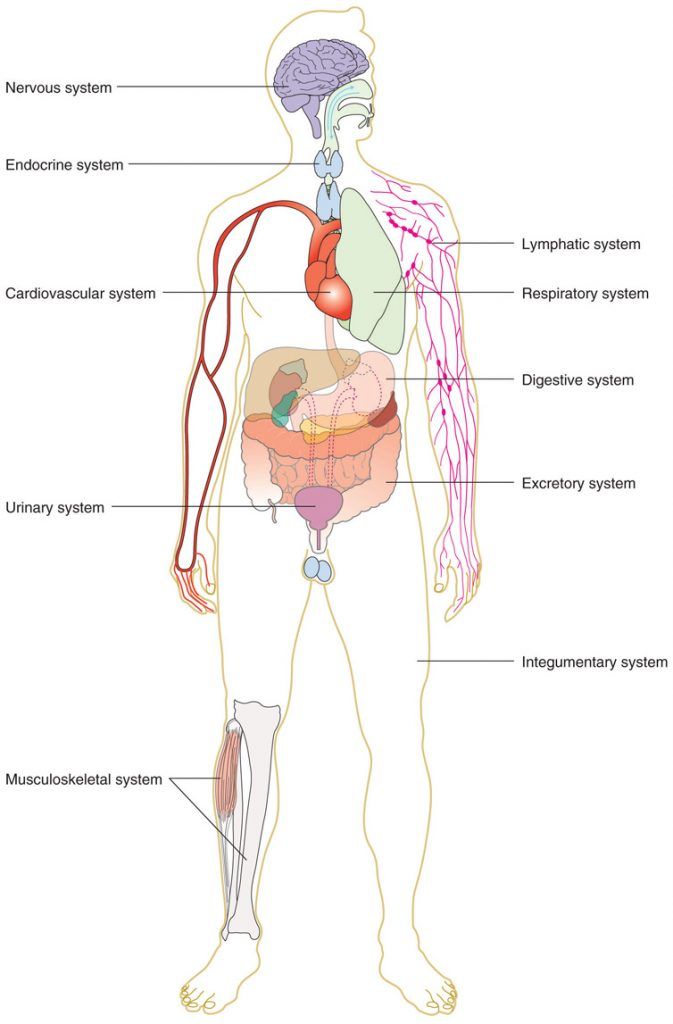University of Hawai‘i at Mānoa Food Science and Human Nutrition Program and Human Nutrition Program
I ola no ke kino i ka māʻona o ka ʻōpū
The body enjoys health when the stomach is full

Learning Objectives
By the end of this chapter, you will be able to:
- Explain the anatomy and physiology of the digestive system and other supporting organ systems
- Describe the relationship between diet and each of the organ systems
- Describe the process of calculating Body Mass Index (BMI)
The Native Hawaiians believed there was a strong connection between health and food. Around the world, other cultures had similar views of food and its relationship with health. A famous quote by the Greek physician Hippocrates over two thousand years ago, “Let food be thy medicine and medicine be thy food” bear much relevance on our food choices and their connection to our health. Today, the scientific community echoes Hippocrates’ statement as it recognizes some foods as functional foods. The Academy of Nutrition and Dietetics defines functional foods as “whole foods and fortified, enriched, or enhanced foods that have a potentially beneficial effect on health when consumed as part of a varied diet on a regular basis, at effective levels.”
In the latter nineteenth century, a Russian doctor of immunology, Elie Metchnikoff, was intrigued by the healthy life spans of people who lived in the tribes of the northern Caucasus Mountains. What contributed to their long lifespan and their resistance to life-threatening diseases? A possible factor lay wrapped up in a leather satchel used to hold fermented milk. Observing the connection between the beverage and longevity, Dr. Elie Metchnikoff began his research on beneficial bacteria and the longevity of life that led to his book, The Prolongation of Life. He studied the biological effects and chemical properties of the kefir elixir whose name came from the Turkish word “kef” or “pleasure.” To this day, kefir is one of the most widely enjoyed beverages in Russia.
Kefir has since found its way into America, where it is marketed in several flavors and can be found at your local grocery store. It is one product of the billion-dollar functional food industry marketed with all sorts of health claims from improving digestion to preventing cancer. What is the scientific evidence that kefir is a functional food? Expert nutritionists agree that probiotics, such as kefir, reduce the symptoms of lactose intolerance and can ward off virally caused diarrhea. While some health claims remain unsubstantiated, scientific studies are ongoing to determine the validity of other health benefits of probiotics.
The Native Hawaiians also consumed a daily probiotic in their diet commonly known as poi (pounded taro). In precolonial Hawai‘i, poi was used for a wide variety of dietary and medicinal purposes. Aside from poi’s nutrient dense composition, fermented poi has numerous compounds created in the fermentation process that are very beneficial to the health of the human body. As a probiotic, evidence suggests that poi can be useful in helping diseases such as diarrhea, gastroenteritis, irritable bowel syndrome, inflammatory bowel disease, and cancer.[1]
Another well-known probiotic to the local people of Hawai‘i is Kimchi. Kimchi is a traditional Korean food that is manufactured by fermenting vegetables (usually cabbage). Similar to the kefir and poi, kimchi also has shown to have similar health benefits as a probiotic food.[2]
The Japanese also have traditional fermented foods such as natto. Natto is made from fermented soybeans and has many health benefits as a probiotic. Along with the beneficial components, natto is very nutrient-dense containing carbohydrates, fats, protein, fiber, vitamins and minerals.[3] Other common foods we ferment in our diet include miso, sauerkraut, kombucha, and tempeh.
Figure 2.1 Components of Organ Systems in the Human Body

Knowing how to maintain the balance of friendly bacteria in your intestines through proper diet can promote overall health. Recent scientific studies have shown that probiotic supplements positively affect intestinal microbial flora, which in turn positively affect immune system function. As good nutrition is known to influence immunity, there is great interest in using probiotic foods and other immune-system-friendly foods as a way to prevent illness. In this chapter we will explore not only immune system function, but also all other organ systems in the human body. We will learn the process of nutrient digestion and absorption, which further reiterates the importance of developing a healthy diet to maintain a healthier you. The evidence abounds that food can indeed be “thy medicine.”
Learning Activities
Technology Note: The second edition of the Human Nutrition Open Educational Resource (OER) textbook features interactive learning activities. These activities are available in the web-based textbook and not available in the downloadable versions (EPUB, Digital PDF, Print_PDF, or Open Document).
Learning activities may be used across various mobile devices, however, for the best user experience it is strongly recommended that users complete these activities using a desktop or laptop computer and in Google Chrome.
- Brown A, Valiere A. (2004). The Medicinal Uses of Poi. Nutrition in Clinical Care, 7(2), 69-74. https://www.ncbi.nlm.nih.gov/pmc/articles/PMC1482315/ ↵
- Park K, Jeong J, et al. (2014). Health Benefits of Kimchi. Journal of Medicinal Food, 17(1), 6-20. https://www.ncbi.nlm.nih.gov/pubmed/24456350 ↵
- Sanjukta S, Rai AK. (2016). Production of bioactive peptides during soy fermentation and their potential health benefits. Trends in Food Science and Technology, 50, 1-10. http://www.sciencedirect.com/science/article/pii/S0924224415300571 ↵
A food that has health promoting qualities beyond nutritional functions.
A claim found on food labels that describes the relationship between a nutrient or food and a disease of health condition.
Live bacteria consumed in a product that is introduced to the body and lives temporarily in the colon and confers health benefits to the host.
A condition that results from the inability to digest lactose. Symptoms include bloating, gas, abdominal pain, discomfort, and diarrhea.
A type of carbohydrate that is indigestible and cannot be broken down by human digestive enzymes.
Comprised of several types of white blood cells that circulate in the blood and lymph. Jobs are to seek, recruit, attack, and destroy foreign invaders, such as bacteria and viruses.

